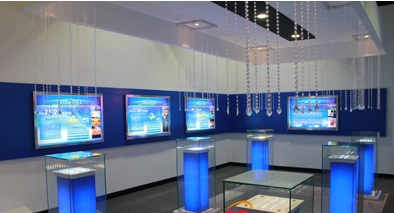 A lighting revolution is taking place quietly in Huanyang Building on the tenth street of Shangdi Science Park. It is only the last step in industrialization. A thin piece of “glass†in the laboratory began to replace incandescent bulbs, fluorescent energy-saving lamps, and emit soft, bright white light. Researchers predict that organic luminescent materials processed by nanotechnology will be more energy-efficient and environmentally-friendly, and will soon end the era of “energy-saving lamps.†The term “bulb†will probably become history and be replaced by “lampsâ€.
A lighting revolution is taking place quietly in Huanyang Building on the tenth street of Shangdi Science Park. It is only the last step in industrialization. A thin piece of “glass†in the laboratory began to replace incandescent bulbs, fluorescent energy-saving lamps, and emit soft, bright white light. Researchers predict that organic luminescent materials processed by nanotechnology will be more energy-efficient and environmentally-friendly, and will soon end the era of “energy-saving lamps.†The term “bulb†will probably become history and be replaced by “lampsâ€. In the 400-square-meter Visconino laboratory on the first floor of the building, the degree of cleanliness even exceeds the operating room in the hospital. A pilot production line of organic light emitting material (OLED) lighting has been established here, which is also a major scientific research project of the Municipal Science and Technology Commission.
Visconnano researchers said that the principle of OLED lighting is organic materials (carbon and hydrogen organic matter, composition and biogas is no difference) under the action of the electric field, the thickness of each layer of organic light-emitting layer is only a few tens of nanometers. "This is white light that is really close to sunlight, and there is no ultraviolet light or infrared light in the sun," the researchers said.
It is reported that incandescent bulbs generate infrared light, energy-saving fluorescent lamps generate ultraviolet light, and OLED light sources are completely absent. In addition, OLED lighting is a continuous spectrum and direct current can be used. This kind of natural light, the light is softer, almost no harm to human vision.
OLED lighting does not need to heat the filament to thousands of degrees Celsius, nor does it need to use mercury vapor to produce ultraviolet light to excite the phosphor. Because there is no multiple conversion process of electric energy, OLED lighting will save about 60% to 70% of electric energy than current energy-saving lamps.
Not only that, OLED lighting can also be manufactured to any geometric pattern according to the customer's requirements. It can even be directly made into a part of the wall, completely changing the shape of the current lighting source.
More importantly, OLED lighting will not produce pollution during production and use. This resolves the current risk of damage to the environment caused by the use of mercury in energy-saving lamps. It is understood that an ordinary energy-saving lamp contains about 5 milligrams of mercury. Once it penetrates underground, it can cause 100 tons of water to be contaminated. Mercury can evaporate at room temperature. After the waste energy-saving lamp is broken, the concentration of mercury in the surrounding air can be exceeded by a hundred times. Once the mercury entering the body exceeds the standard, it will destroy the human central nervous system, and even cause death. There are hundreds of millions of mercury-containing lighting lamps that are scrapped every year in China. The amount of mercury released into the atmosphere and water environment due to improper disposal is as high as tens of tons.
According to the person in charge of the Municipal Science and Technology Commission, the next generation of lighting adopts high-end automation and precision equipment for production, and is a green clean production project that is energy-saving, water-saving, and low-carbon and environmentally friendly. This high-end manufacturing industry meets the requirements of the “beautiful China†ecological civilization and environment construction. It is expected to become a booster for the transformation and upgrading of the regional economy.
It is understood that OLED lighting is also a cutting-edge technology in the current world, Philips, OSRAM and other multinational companies are conducting OLED lighting technology research and commitment to industrialization. In the future, this technology is expected to form another huge industry with 100 billion yuan output value. The domestic OLED lighting market is expected to reach a scale of several billion yuan by 2020.
With the support of the Ministry of Science and Technology and the Beijing Municipal Government, this major scientific research project has enabled Beijing to gain a leading position in the next generation of lighting technology and is basically in sync with the international level. “We launched OLED lighting fixtures in 2009, and we have completed the integration of process technology. Now we have introduced a number of OLED lighting fixtures.†According to the head of Visionox Lighting Project, “We estimate that hundreds of millions will be established between 2014 and 2015. Yuan's OLED lighting mass production line."
Black Light Tube,Blb Tube,Blb Bulb,Blb Lamp
Changxing leboom lighting product CO.Ltd. , https://www.leboomuv.com
